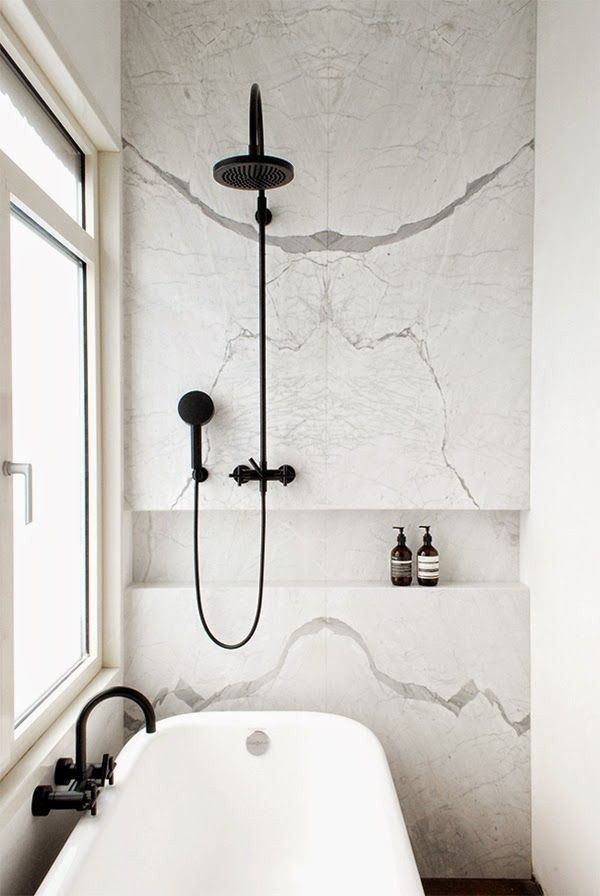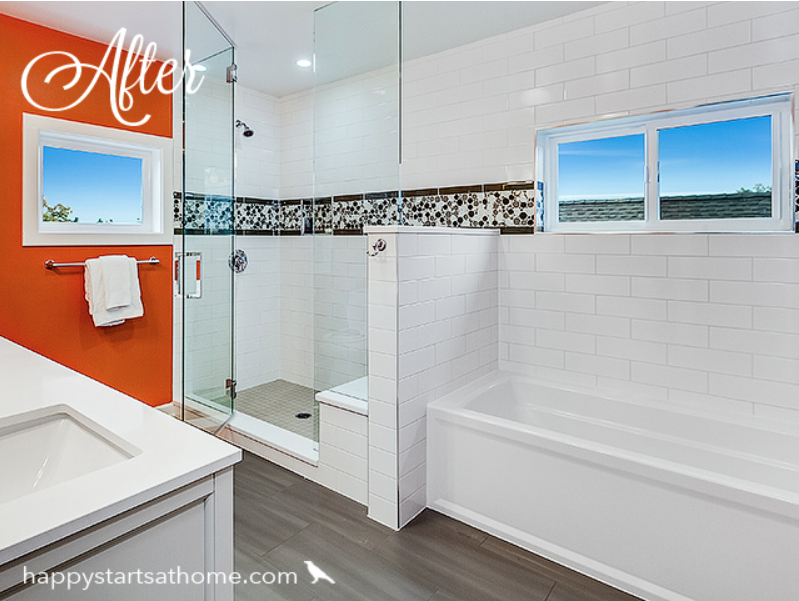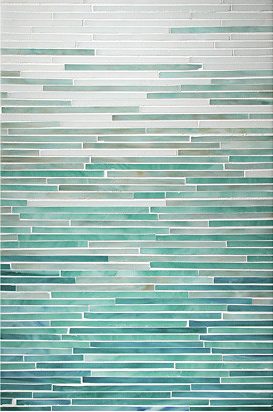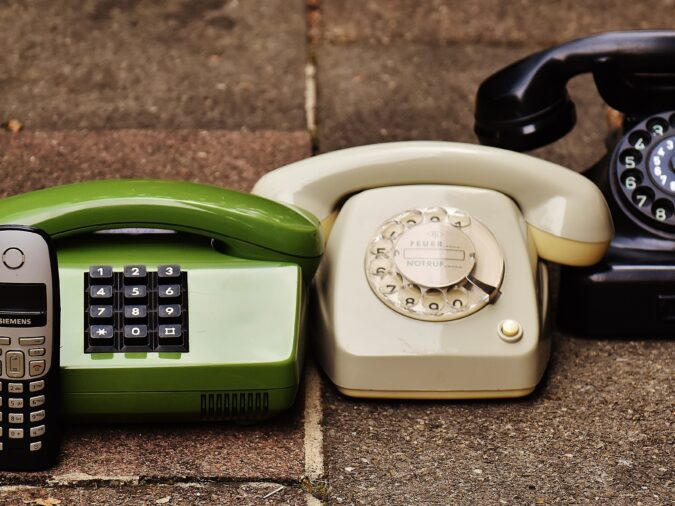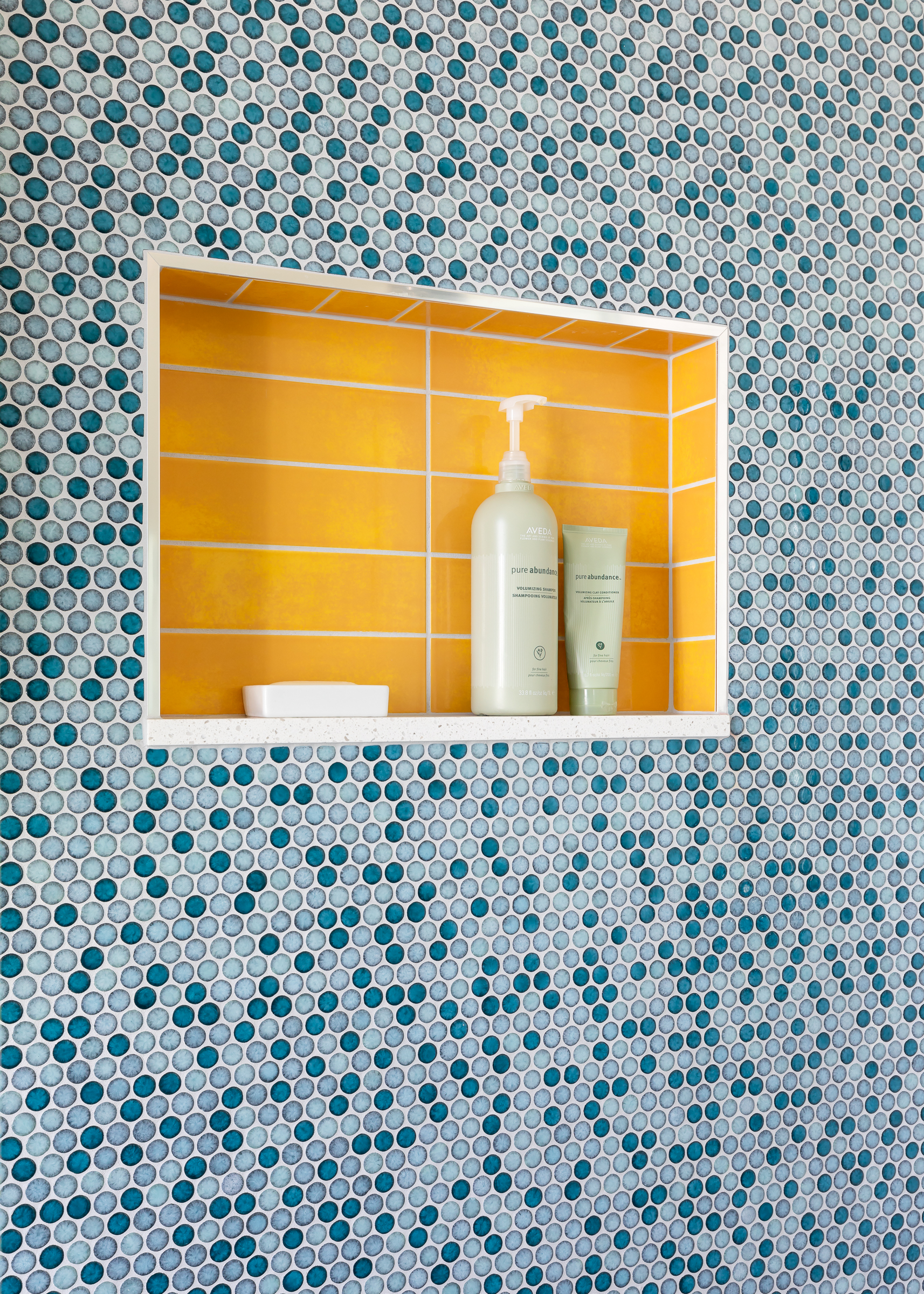What’s Your Tile Style? Pros and Cons of Tile Types
What’s Your Tile Style? Pros and Cons of Tile Types

Eager to get happy at home right now?
Get 10 tips for a happier home!
So, you need to choose tile for your bathroom, backsplash, or fireplace – where do you start? You need it to be the right aesthetic fit, sure, but you also need it to be functional for the application. Let’s talk about types of tile and which is best for which kinds of applications so that you don’t end up installing something you’ll regret. We only want to spend this money, once, right? 😉

Porcelain tile is one of the most common types of tile out there, and lucky for us it’s one of the most versatile options for surfaces! It is created by using a clay with fine particles that is then fired at a high temperature, creating a hard glazed surface thus making it very durable.

Check out these amazing, giant-sized tiles on this bathroom wall. It Looks like a stone slab, but it’s actually 1/4” thick tile!!
Porcelain Tile Pros:
➤ Versatile: It can be used almost anywhere, even outdoors.
➤ Large-format: Porcelain tiles come in both large and small sizes, but where they stand apart from other materials is in the “large-format” category. We usually mean about 12” x 24” when we say “large format” but they are sometimes as big as countertop slabs these days! What’s the benefit to a large format tile? Less grout! And less grout means less maintenance! Winning!
➤ A design chameleon!: Can duplicate many different types of materials such as marble, slate, travertine, cork, wood, metal, the possibilities are endless! This means you can get the look of higher-maintenance materials without the headaches – yea!
➤ Water resistant: The tile is very dense so there is little to no water absorption. (That’s one of the reasons it can usually be used outdoors because it won’t be damaged by a freeze-thaw cycle.)
➤ Stain resistant: Because it’s so dense, staining agents can’t easily penetrate the surface.
➤ Low maintenance: You don’t have to worry what kind of cleaners you use on this tile!
➤ Repairable (kind of): You can’t repair an individual tile, but if you manage to crack a tile you can replace the individual tile, so be sure to keep an extra tile or two stashed away if you want that option down the road.
➤ Some porcelain tile comes “rectified”: This means the factory edges very precise and that allows for really tight grout lines. If you like a minimalist look, this is great for you!
Porcelain Tile Cons:
➤ As mentioned, these days porcelain tiles come in amazing large sizes but beware, large tiles need to be laid on a very flat substrate surface or they will be prone to cracking, especially on a floor.
➤ Large scale pieces can have a slight bow so you cannot set the tile in a 50/50 brick pattern (you’ll end up with kind of waffle weave texture that you’ll feel and that can catch toes and dirt). This bowing also makes it less than ideal to cut down to smaller pieces, ie going from 12×24 to 3×12 – they would not lay flat and you’d have to compensate for that with larger grout lines.
➤ Being so dense makes it harder for a DIYer to work with. Cutting porcelain tile requires a wet saw with a porcelain diamond blade.

Nope – that’s not a wood floor – it’s tile! The knots, veining and shading make this porcelain tile look like the real deal, but it’s waterproof so you can put it anywhere.

Ceramic tile is also made from clay and fired in a kiln, just like porcelain tile. The main difference is that the clay used to make porcelain tile is more refined and purified, and it’s fired at a higher temperature, so porcelain is more dense, durable, and versatile. But if you are looking for a less costly option, or a more handmade look, you may find yourself looking at ceramic tile.
Ceramic Tile Pros:
➤ Cost Effective: Less expensive than porcelain tile.
➤ Water REsistant: Okay for showers and steam showers.
➤ Repairable: Just like porcelain tile, you can replace the individual tile.
➤ Low maintenance!
➤ DIY friendly: Good for a DIYer because it is softer than porcelain and is easier to cut and install.
Ceramic Tile Cons:
➤ Since it is less dense than porcelain it can absorb water (not through the glazed front surface, but through the sides and back). This means it shouldn’t be used outdoors because it will crack during a freeze-thaw cycle.
➤ Lower grade versions (rated on in strength grades 1-4) can chip and scratch more easily.
➤ If a tile chips you will see the clay underneath the glaze, whereas a porcelain often has the color going all the way through and a chip (which is harder to cause in the first place) keep the original color.
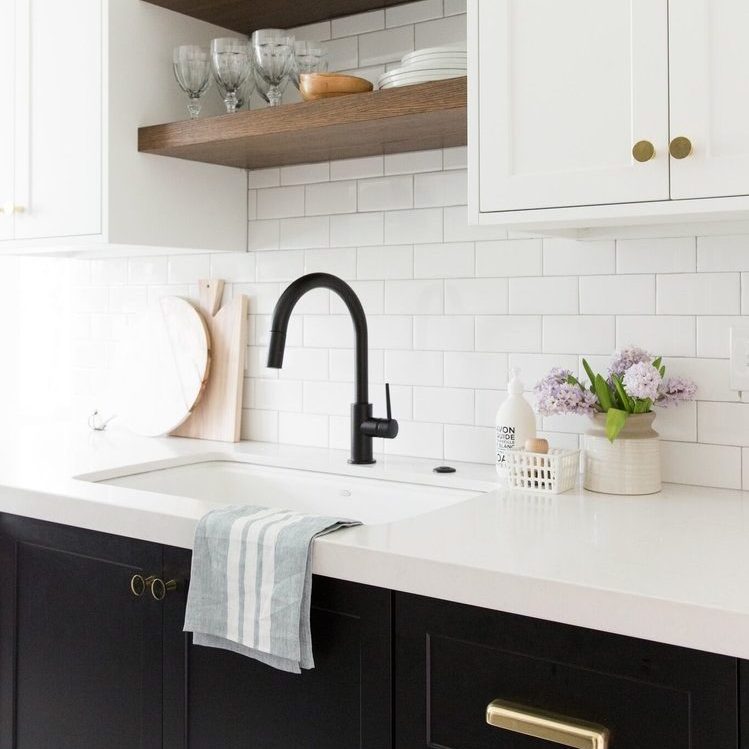
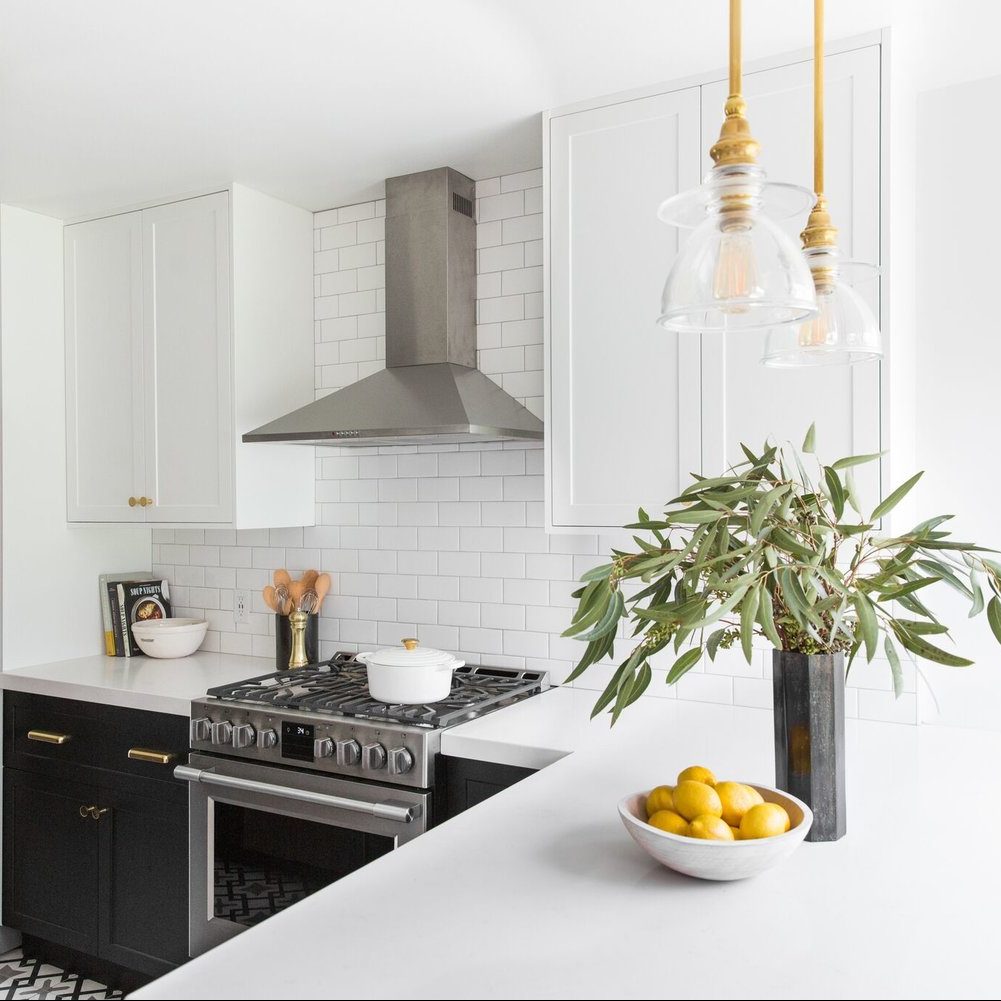 Ceramic subway tile is a classic, cost-effective, and timeless choice for a backsplash.
Ceramic subway tile is a classic, cost-effective, and timeless choice for a backsplash.

Natural stone covers all tile that is quarried straight from the earth. Marble, limestone, travertine, slate and onyx are all beautiful materials that have qualities that can be mimicked, but never completely replicated in man-made materials.
Natural Stone Pros:
➤ Unique: Each piece is unique, no two pieces are the same.
➤ Timeless: It’s a classic and timeless selection for your home.
➤ ReSale friendly: It usually adds value to your home and is appealing to prospective buyers (depending on your market).
Natural Stone Cons:
➤ Not suggested for use in steam showers. To find out why you can click here right here!
➤ Not suggested for use on a wood burning fireplace (the smoke tends to stain the natural stone).
➤ Can be expensive (but not always – there are lots of grades of natural stone).
➤ Higher maintenance than porcelain or ceramic. You must clean it with ph neutral cleaners, and some stone stains and scratches easily (for example, onyx and soapstone scratch easily, and marble, limestone, and travertine stain and etch in response to anything acidic, like wine). Assume your natural stone will show age or patina over time (not necessarily a bad thing, but something to be aware of).
➤ Most stone options should be sealed annually to help resist stains.
If you are going to choose natural stone, be sure to higher a great tile installer so that they help show off the unique characteristics (like veining). Above the installer “book matched” the tiles to create that gorgeous butterfly effect! Other times you may have one or two tiles that seem out of place with the other tiles – even if mother nature created something random, you may not want a random light tile in a field of all dark, or that one tile with a big red iron stain in the middle of it right in your line of sight, so make sure your tile installer is on your side and thinking like a craftsman, not just a laborer.


The iridescent blue moroccan tile is such a WOW factor in this bar; a perfect example of the show stopping color and shapes of glass tile.
Glass tile is made from thin pieces of glass either with color running through the glass or with colored, metallic, or patterned glaze fired onto the back of each tile. They can create a beautiful statement in your home!
Glass Tile Pros:
➤ Show-stopping: There are so many different varieties and colors!
➤ Reflective: This feature allows them to bounce light around a room, visually expanding your space.
➤ Low maintenance: Easy to clean and maintain (unless it’s a matte finish, which can hold onto greasy finger prints).
➤ Water proof: Zero water absorption.
Glass Tile Cons:
➤ Not as DIY friendly: requires precision cutting (the cuts look pretty rough if you do a less-than-perfect job) and the mastic (glue) is visible through the tile (the installer has to even out the trowel marks, and needs to consider the color of the adhesive).
➤ Can be considerably more expensive than ceramic or stone. Many people use it in small amounts as an accent stripe within the shower field tile, or in the back of a niche.

Encaustic tile probably pops up regularly in your Pinterest feed, and for good reason – it is gorgeous!
First, about the name: In the design world the term “encaustic tile” is now used to describe pretty much any tile with a kind of Morrocon / Global / usually high-contrast motif to it, usually in a 8×8 to 12×12 square size. The true meaning of “encaustic” has *nothing* to do with how the tile is made (want to learn more about how it got this mis-naming? Check out this outstanding blog by our colleague Kristie Barnett).
Second, there are two types of tile in this family – cement based, and porcelain. As mentioned above, porcelain is low-maintenance and super durable. Cement tile, on the other hand, is like limestone, marble, and travertine. Unless well (and regularly) sealed, it *will* stain and patina over time. The porcelain version doesn’t have quite the same richness and old-world feel to it, but many people are willing to sacrifice the authenticity for the lower maintenance. Up to you! No matter what, choosing an encaustic style tile will add tons of personality to your home!
Encaustic Tile Pros:
➤ Stunning: Beautifully crafted designs and patterns.
➤ Old world look 😍
➤ Practical: Scratch resistant and less likely to cause slip and falls (in the cement version)
➤ Durable: Long lasting (but not necessarily stain resistant, if in the cement version)
Encaustic Tile Cons:
➤ Inconsistent size making installation longer (and more expensive!) – again, in the cement version. This means you will need to hire an awesome installer, somebody that will take their time and do the job correctly. Think craftsman, not laborer.
➤ Prone to stains and etching, consider where you will be installing it – yep, just the cement version.
➤ More pricey.
➤ Most commonly 8×8 tile size (not necessarily a con, but a limitation).
If you have your heart set on encaustic tiles but want a lower maintenance tile, do consider using a porcelain tile. Manufacturers really have come out with amazing lookalikes!


 Such a pretty tile surround that Amber Interiors used it in the bathroom as well.
Such a pretty tile surround that Amber Interiors used it in the bathroom as well.
Here are a few encaustic porcelain options to inspire your next project. 😀
And there you have it! Who knew there was so much to selecting tile, and that’s not even diving into colors, layouts, or size! Whew!
Hopefully that gives you a little more insight as you embark on your next remodel and you can narrow down the type of tile that is right for your project. If you’re feeling overwhelmed, remember there are folks out there (like us) ready to help! We’d love to meet virtually in a Design Helpline to chat you through the options and what’s best for your space!
May your home always be happy!

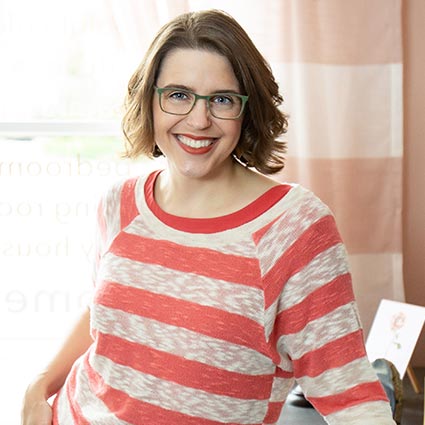
HI, I'M REBECCA WEST!
I’m an interior designer, author, podcaster, speaker, and coach to other designers. (Whew!) But I’m not your classic interior designer because, frankly, I don’t care if you buy a new sofa. I do care if your home supports your goals and feels like “you.” Remember, happy starts at home!
More From Seriously Happy Homes
Are you ready for a seriously happy home?
(Cue the confetti!)

Eager to get happy at home right now?

